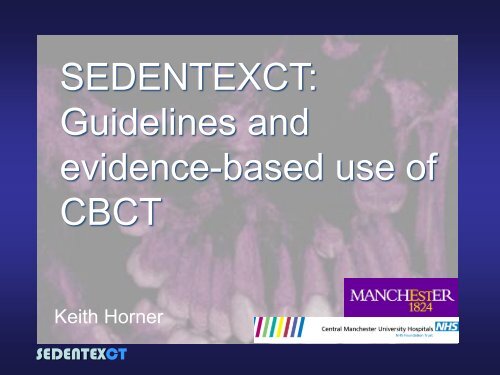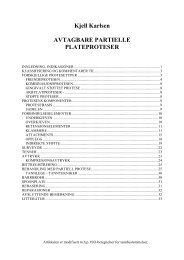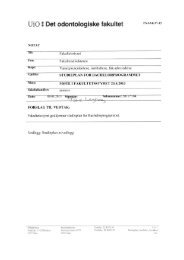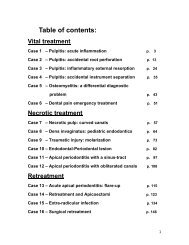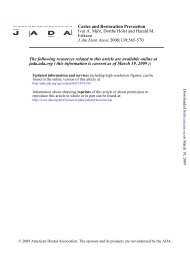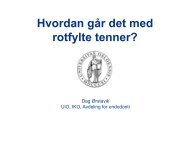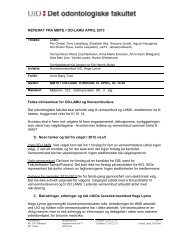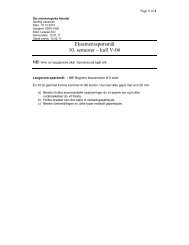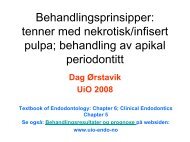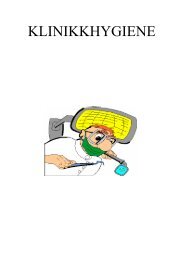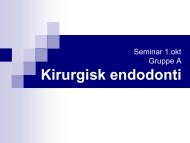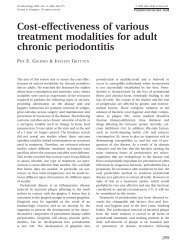SEDENTEXCT: Guidelines and evidence-based use of CBCT
SEDENTEXCT: Guidelines and evidence-based use of CBCT
SEDENTEXCT: Guidelines and evidence-based use of CBCT
You also want an ePaper? Increase the reach of your titles
YUMPU automatically turns print PDFs into web optimized ePapers that Google loves.
<strong>SEDENTEXCT</strong>:<strong>Guidelines</strong> <strong>and</strong><strong>evidence</strong>-<strong>based</strong> <strong>use</strong> <strong>of</strong><strong>CBCT</strong>Keith Horner<strong>SEDENTEXCT</strong>
<strong>SEDENTEXCT</strong>
John DaltonRutherfordBraggUK largest single-siteUniversity34,000 students<strong>SEDENTEXCT</strong>
University Dental Hospital <strong>of</strong>Manchester90,000 patients attend fortreatment every year<strong>SEDENTEXCT</strong>
<strong>SEDENTEXCT</strong>
<strong>CBCT</strong> serviceFor our own hospitalsFor other hospitals inthe regionFor private dentists(mainly implantdentists)<strong>SEDENTEXCT</strong>
Cone Beam Computed Tomography (<strong>CBCT</strong>)<strong>SEDENTEXCT</strong>
30+ <strong>CBCT</strong> systems marketed worldwidehttp://www.conebeam.com/cbctchart<strong>SEDENTEXCT</strong>
Radiation dose implications<strong>SEDENTEXCT</strong>
<strong>SEDENTEXCT</strong>: the backgroundIn 2006/7:•New technology (<strong>CBCT</strong>)•Evidence that <strong>CBCT</strong> gavehigher doses <strong>of</strong> radiation topatients•Little <strong>evidence</strong> <strong>of</strong> the diagnosticvalue <strong>and</strong> limitations <strong>of</strong> <strong>CBCT</strong>•Challenges for dentists <strong>and</strong>medical physics experts wantingto install <strong>CBCT</strong>•No guidelines anywhere on“good practice”<strong>SEDENTEXCT</strong>
<strong>SEDENTEXCT</strong>: the background<strong>SEDENTEXCT</strong>
<strong>SEDENTEXCT</strong>: the backgroundIn 2007:•European consortium <strong>of</strong>Universities•A manufacturer <strong>of</strong> medical X-ray test objects<strong>SEDENTEXCT</strong>
Safety <strong>and</strong> Efficacy <strong>of</strong> a New <strong>and</strong> Emerging DentalX-ray Modality1. To develop <strong>evidence</strong>-<strong>based</strong>guidelines on the <strong>use</strong> <strong>of</strong> <strong>CBCT</strong>in dentistry, covering referralcriteria, quality assurance <strong>and</strong>other optimisation strategies.<strong>SEDENTEXCT</strong>
Safety <strong>and</strong> Efficacy <strong>of</strong> a New <strong>and</strong> Emerging DentalX-ray Modality2. To determine patient dosein <strong>CBCT</strong>, with an emphasison paediatric dosimetry, <strong>and</strong>personnel dose.<strong>SEDENTEXCT</strong>
Safety <strong>and</strong> Efficacy <strong>of</strong> a New <strong>and</strong> Emerging DentalX-ray Modality3. To perform diagnosticaccuracy studies for <strong>CBCT</strong>in key clinical applications indentistry.<strong>SEDENTEXCT</strong>
Safety <strong>and</strong> Efficacy <strong>of</strong> a New <strong>and</strong> Emerging DentalX-ray Modality4. To develop a qualityassurance (QA) programme,including the development <strong>of</strong> atool/tools for QA <strong>and</strong> to defineexposure protocols.<strong>SEDENTEXCT</strong>
Safety <strong>and</strong> Efficacy <strong>of</strong> a New <strong>and</strong> Emerging DentalX-ray Modality5. To make an economicevaluation (“cost effectiveness”assessment) <strong>of</strong> <strong>CBCT</strong>compared with traditionalmethods <strong>of</strong> dental imaging.<strong>SEDENTEXCT</strong>
Safety <strong>and</strong> Efficacy <strong>of</strong> a New <strong>and</strong> Emerging DentalX-ray Modality6. To conduct valorisation,both dissemination <strong>and</strong>training, activities via anopen access website.<strong>SEDENTEXCT</strong>www.sedentexct.eu
Safety <strong>and</strong> Efficacy <strong>of</strong> a New <strong>and</strong> Emerging DentalX-ray ModalityEvidence-<strong>based</strong> guidelines onthe <strong>use</strong> <strong>of</strong> <strong>CBCT</strong> in dentistry,covering referral criteria, qualityassurance <strong>and</strong> otheroptimisation strategies.Systematic review <strong>of</strong> the<strong>evidence</strong><strong>SEDENTEXCT</strong>
What are clinical guidelines?“systematically developed statements to assistpractitioner <strong>and</strong> patient decisions aboutappropriate health care for specific clinicalcircumstances”Field, MJ, Lohr, KN, (eds). <strong>Guidelines</strong> for clinical practice: from development to <strong>use</strong>.National Academy Press, Washington D.C., 1992.<strong>SEDENTEXCT</strong>
<strong>CBCT</strong> is not indicated as a method <strong>of</strong>caries detection <strong>and</strong> diagnosisB<strong>CBCT</strong> equipment should be installed in aprotected enclosure <strong>and</strong> the whole <strong>of</strong> theenclosure designated a Controlled AreaD<strong>CBCT</strong> is not normally indicated forplanning the placement <strong>of</strong> temporaryanchorage devices in orthodonticsGP<strong>SEDENTEXCT</strong>
<strong>SEDENTEXCT</strong>GradeAAt least one meta analysis, systematic review, or RCTrated as 1++, <strong>and</strong> directly applicable to the targetpopulation; or a systematic review <strong>of</strong> RCTs or a body <strong>of</strong><strong>evidence</strong> consisting principally <strong>of</strong> studies rated as 1+,directly applicable to the target population, <strong>and</strong>demonstrating overall consistency <strong>of</strong> resultsB A body <strong>of</strong> <strong>evidence</strong> including studies rated as 2++,directly applicable to the target population, <strong>and</strong>demonstrating overall consistency <strong>of</strong> results; orextrapolated <strong>evidence</strong> from studies rated as 1++ or 1+C A body <strong>of</strong> <strong>evidence</strong> including studies rated as 2+,directly applicable to the target population <strong>and</strong>demonstrating overall consistency <strong>of</strong> results; orextrapolated <strong>evidence</strong> from studies rated as 2++D Evidence level 3 or 4; or extrapolated <strong>evidence</strong> fromstudies rated as 2+GP Good Practice (<strong>based</strong> on clinical expertise <strong>of</strong> theguideline group <strong>and</strong> Consensus <strong>of</strong> stakeholders)Scottish Intercollegiate <strong>Guidelines</strong>Network (SIGN), 2008
Lecture outline:First part:Justification <strong>and</strong> referral criteria•How strong is the <strong>evidence</strong> for using <strong>CBCT</strong> forspecific clinical applications?•<strong>SEDENTEXCT</strong> referral criteriaSecond part:Radiation dose, dose limitation <strong>and</strong> qualityassurance for <strong>CBCT</strong>•Highlight the clinical relevance•<strong>SEDENTEXCT</strong> guidelines<strong>SEDENTEXCT</strong>
Justification<strong>and</strong> referralcriteria“To scan, or not toscan, that is thequestion.....”<strong>SEDENTEXCT</strong>
Radiation Protection principlesInternational Commission onRadiological Protection (ICRP)Three fundamental principles <strong>of</strong> radiologicalprotection:•justification•optimisation•[the application <strong>of</strong> dose limits]The 2007 Recommendations <strong>of</strong> the International Commission on Radiological Protection . Annals <strong>of</strong> theICRP Vol 37 (2007)http://www.icrp.org/docs/ICRP_Publication_103-Annals_<strong>of</strong>_the_ICRP_37%282-4%29-Free_extract.pdf<strong>SEDENTEXCT</strong>
Radiation Protection principlesJustification“The process <strong>of</strong> determining whether a plannedactivity involving radiation is, overall, beneficial,i.e. whether the benefits to individuals <strong>and</strong> tosociety from introducing or continuing the activityoutweigh the harm (including radiation detriment)resulting from the activity”The 2007 Recommendations <strong>of</strong> the International Commission on Radiological Protection . Annals <strong>of</strong> theICRP Vol 37 (2007)http://www.icrp.org/docs/ICRP_Publication_103-Annals_<strong>of</strong>_the_ICRP_37%282-4%29-Free_extract.pdf<strong>SEDENTEXCT</strong>
Radiation Protection principlesJustification“....should do more good than harm”The 2007 Recommendations <strong>of</strong> the International Commission on Radiological Protection . Annals <strong>of</strong> theICRP Vol 37 (2007)http://www.icrp.org/docs/ICRP_Publication_103-Annals_<strong>of</strong>_the_ICRP_37%282-4%29-Free_extract.pdf<strong>SEDENTEXCT</strong>
What are radiological referral criteria?Referral criteria areNOT:“...a rigid constraint onclinical practice, but aconcept <strong>of</strong> goodpractice against whichthe needs <strong>of</strong> theindividual patient canbe considered”Good practiceIndividualprescription <strong>of</strong> X-ray <strong>based</strong> imaging<strong>SEDENTEXCT</strong>
3-dimensions versus 2-dimensions<strong>SEDENTEXCT</strong>
The “trade <strong>of</strong>f”High resolution - 2DLower resolution - 3D<strong>SEDENTEXCT</strong>
Not all <strong>CBCT</strong> machines are the same!Liang X et al. (2010) A comparative evaluation <strong>of</strong> Cone BeamComputed Tomography (<strong>CBCT</strong>) <strong>and</strong> Multi-Slice CT (MSCT): Part I.On subjective image quality. Eur J Radiol 75: 265-269.<strong>SEDENTEXCT</strong>
What do dentists do?Dental caries(decay)Extract teethPeriodontaldiseaseFill “gaps” inthe dentitionPulpaldisease <strong>and</strong>root canaltreatmentsToothtraumaOrthodontictreatmentsAesthetictreatments<strong>SEDENTEXCT</strong>
Caries detectionBitewing radiography:Proximal caries:Mean sensitivity 50%Mean specificity 87%Occlusal caries:Mean sensitivity 39%Mean specificity 91%Bader JD et al Systematic reviews <strong>of</strong> selecteddental caries diagnostic <strong>and</strong> managementmethods. J Dent Educ. 2001 65: 960-8.<strong>SEDENTEXCT</strong>
Caries detection<strong>SEDENTEXCT</strong>
Caries detection: <strong>CBCT</strong>In 5 out <strong>of</strong> 7 researchstudies on proximalcaries: no significantdifferences between<strong>CBCT</strong> <strong>and</strong> bitewingradiographyIn 2 studies there washigher sensitivity for<strong>CBCT</strong><strong>SEDENTEXCT</strong>
Caries detection: <strong>CBCT</strong>In all 3 research studieson occlusal caries: <strong>CBCT</strong>had higher sensitivitythan bitewingradiographyBut there may be loss <strong>of</strong>specificity (more “falsepositive” results).<strong>SEDENTEXCT</strong>
The artefact problem<strong>SEDENTEXCT</strong>
Caries detection: <strong>CBCT</strong><strong>CBCT</strong> is not indicated as a method<strong>of</strong> caries detection <strong>and</strong> diagnosisB<strong>SEDENTEXCT</strong>
Periodontal diagnosisPrimary diagnosticmethod is clinicalexaminationLimited research on<strong>CBCT</strong><strong>SEDENTEXCT</strong>
Periodontal diagnosis<strong>CBCT</strong> may be moreaccurate for detection<strong>and</strong> quantification <strong>of</strong>inter-radicular bonedefects/ furcationlesionsMay be <strong>use</strong>ful inevaluating the responseto surgery <strong>and</strong>regenerative treatment<strong>of</strong> intra-bony defects.<strong>SEDENTEXCT</strong>
Periodontal diagnosis<strong>CBCT</strong> is not indicated as a routinemethod <strong>of</strong> imaging periodontalbone supportCLimited volume, high resolution <strong>CBCT</strong> maybe indicated in selected cases <strong>of</strong> infra-bonydefects <strong>and</strong> furcation lesions, where clinical<strong>and</strong> conventional radiographic examinationsdo not provide the information needed formanagementC<strong>SEDENTEXCT</strong>
<strong>SEDENTEXCT</strong>
Periapical diagnosis<strong>CBCT</strong>Properly validated in vivostudies impossibleLaboratory <strong>and</strong> animal studiespossible <strong>and</strong> suggest improvedsensitivity <strong>of</strong> <strong>CBCT</strong>Simple comparative clinicalstudiesConventional“34% <strong>of</strong> lesions were missedby periapical radiography” (Lowet al 2008)<strong>SEDENTEXCT</strong>
Periapical diagnosis<strong>CBCT</strong> is not indicated as a st<strong>and</strong>ardmethod for identification <strong>of</strong> periapicalpathosisGPLimited volume, high resolution <strong>CBCT</strong> maybe indicated for periapical assessment, inselected cases, when conventionalradiographs give a negative finding whenthere are contradictory positive clinicalsigns <strong>and</strong> symptomsGP<strong>SEDENTEXCT</strong>
Endodontics<strong>CBCT</strong> identifies “more rootcanals” than conventionalradiographyAll posterior teethRequires high resolution<strong>CBCT</strong>:? 0.12 mm resolution (orbetter)<strong>SEDENTEXCT</strong>
Endodontics<strong>CBCT</strong> is not indicated as ast<strong>and</strong>ard method fordemonstration <strong>of</strong> root canalanatomyGP<strong>CBCT</strong>Limited volume, high resolution <strong>CBCT</strong>may be indicated,for selected cases,where intraoral radiographs provideinformation on root canal anatomywhich is equivocal or inadequate forplanning treatment, most probably inmulti-rooted teethGPConventional<strong>SEDENTEXCT</strong>
Complex endodontic casesPerio-endo lesions<strong>SEDENTEXCT</strong>
Complex endodontic casesPerio-endo lesionsRe-treatment cases<strong>SEDENTEXCT</strong>
Complex endodontic casesPerio-endo lesionsRe-treatment casesResorption cases<strong>SEDENTEXCT</strong>
Complex endodontic casesPerio-endo lesionsRe-treatment casesResorption cases<strong>SEDENTEXCT</strong>
Complex endodontic casesLimited volume, high resolution <strong>CBCT</strong> maybe justifiable for selected cases, whereendodontic treatment is complicated byconcurrent factors, such as resorptionlesions, combined periodontal/endodonticlesions, perforations <strong>and</strong> atypical pulpanatomyC<strong>SEDENTEXCT</strong>
ImplantologyMain driver fordevelopment <strong>of</strong> <strong>CBCT</strong>Conventional (medical)CT has been the mainmethodUsually radiationdose advantage <strong>of</strong><strong>CBCT</strong><strong>SEDENTEXCT</strong>
ImplantologySpecial indications for cross-sectional imaging (adapted from Fig. 2b inHarris et al 2002 E.A.O. <strong>Guidelines</strong> for the <strong>use</strong> <strong>of</strong> diagnostic imaging inimplant dentistry. Clin Oral Implants Res 2002; 13: 566-570).MaxillaSingletoothM<strong>and</strong>ible Singletooth<strong>SEDENTEXCT</strong>a. incisive canalb. descent <strong>of</strong> maxillary sinusc. clinical doubt about shape <strong>of</strong> alveolar ridgea. descent <strong>of</strong> maxillary sinusb. clinical doubt about shape <strong>of</strong> alveolar ridgePartiallydentateEdentulous a. descent <strong>of</strong> maxillary sinusb. clinical doubt about shape <strong>of</strong> alveolar ridgea. clinical doubt about position <strong>of</strong> m<strong>and</strong>ibular canalb. clinical doubt about shape <strong>of</strong> alveolar ridgePartiallydentatea. clinical doubt about position <strong>of</strong> m<strong>and</strong>ibular canalor mental foramenb. clinical doubt about shape <strong>of</strong> alveolar ridgeEdentulous a. severe resorptionb. clinical doubt about shape <strong>of</strong> alveolar ridgec. clinical doubt about position <strong>of</strong> m<strong>and</strong>ibular canalif posterior implants are to be placed
<strong>SEDENTEXCT</strong>
“Bone quality” assessment•Cortical thinning•Cortical porosity•Sparse trabeculation•Difficulty in visualising neurovascularcanals<strong>SEDENTEXCT</strong>
Implantology<strong>CBCT</strong> is indicated for crosssectionalimaging prior to implantplacement as an alternative toexisting cross-sectional techniqueswhere the radiation dose <strong>of</strong> <strong>CBCT</strong>is shown to be lowerD<strong>SEDENTEXCT</strong>
ImplantologyFor cross-sectional imaging prior toimplant placement, the advantage<strong>of</strong> <strong>CBCT</strong> with adjustable fields <strong>of</strong>view, compared with multislice CT,becomes greater where the region<strong>of</strong> interest is a localised part <strong>of</strong> thejaws, as a similar sized field <strong>of</strong>view can be <strong>use</strong>dGP<strong>SEDENTEXCT</strong>
Implant review<strong>SEDENTEXCT</strong>
Localising unerupted <strong>and</strong> impacted teethNumerous case reports <strong>and</strong> nonsystematicreviews on <strong>CBCT</strong> <strong>use</strong>for 3 rd molar assessmentFocus on lower third molar <strong>and</strong>ID canal relationshipCone-beam CT revealed the number<strong>of</strong> roots <strong>of</strong> teeth more reliably thanpanoramic radiographs. Suomalainen etal 2010 Dentomaxill<strong>of</strong>acial Radiology,109: 276-84.<strong>SEDENTEXCT</strong>
Third molarsConflicting <strong>evidence</strong>on whether <strong>CBCT</strong> ismore accurate inpredictingneurovascular bundleexposure duringextraction <strong>of</strong> impactedm<strong>and</strong>ibular third molarteeth.<strong>SEDENTEXCT</strong>
PanoramicPanoramic <strong>CBCT</strong>reformat<strong>SEDENTEXCT</strong>
Third molarsWhere conventional radiographssuggest a direct inter-relationshipbetween a m<strong>and</strong>ibular third molar<strong>and</strong> the m<strong>and</strong>ibular canal, <strong>and</strong>when a decision to performsurgical removal has been made,<strong>CBCT</strong> may be indicatedC<strong>SEDENTEXCT</strong>
Third molarsFactors associated with post-operative dysaesthesia•“Darkening” <strong>of</strong> theroot•Interruption <strong>of</strong> thecanal wall•Diversion <strong>of</strong> thecanal(Rood & Shehab, 1990)<strong>SEDENTEXCT</strong>
Other teeth: maxillary canines<strong>SEDENTEXCT</strong>
Detection <strong>of</strong> root resorptionIn vitro studies<strong>of</strong> diagnosticaccuracyTable IV. Sensitivity <strong>and</strong> specificity <strong>of</strong> resorption detection forthe 3 radiologic imaging methods, expressed as percentagesPanoramic<strong>CBCT</strong>Accuitomo<strong>CBCT</strong>ScanoraSensitivity 78 95 94Specificity 38 75 75False-positive errors 63 25 25False-negative errors 22 5 6Alqerban A, Jacobs R, Souza PC, Willems G.Am J Orthod Dent<strong>of</strong>acial Orthop. 2009Dec;136(6):764.e1-11Improved diagnostic accuracy <strong>of</strong> <strong>CBCT</strong>shown in other studies in endodonticliterature<strong>SEDENTEXCT</strong>
Detection <strong>of</strong> root resorptionIn vivo studies27 patients39 ectopic canines•<strong>CBCT</strong>•Conventional (pan,ceph, intraorals)8 observers82.7% agreementin resorptionassessment<strong>SEDENTEXCT</strong>Botticelli S et al., Eur J Orthod 2011, 33: 344-349
Effect on treatment plansBotticelli et al., 2011Change in treatment plan in 29.5% <strong>of</strong> cases<strong>SEDENTEXCT</strong>Botticelli S et al., Eur J Orthod 2011, 33: 344-349
<strong>CBCT</strong> may be indicated for the localisedassessment <strong>of</strong> an impacted tooth (includingconsideration <strong>of</strong> resorption <strong>of</strong> an adjacenttooth) where the current imaging method <strong>of</strong>choice is conventional dental radiography<strong>and</strong> when the information cannot be obtainedadequately by lower dose conventional(traditional) radiographyC<strong>SEDENTEXCT</strong>
“General” orthodontic assessment<strong>SEDENTEXCT</strong>
<strong>CBCT</strong> in Orthodontics: the “hype”“NO MORE DENTALIMPRESSIONS!”<strong>SEDENTEXCT</strong>“….builds 2D lateral <strong>and</strong> PA cephalograms…”“a necessity for the orthodontist”“One 24 sec scan <strong>of</strong> an orthodontic patientyields a 3D image <strong>of</strong> the head <strong>and</strong> neck!”“We have to embrace[<strong>CBCT</strong>]… <strong>and</strong> incorporateit into our everyday“Less exposure than the old way <strong>of</strong> gatheringdiagnostic data on our patients”treatment planning” “We have eliminated dentalimpressions in our practice”“The information provided by <strong>CBCT</strong> ....is more comprehensive <strong>and</strong>much more accurate (diagnostic truth)”
<strong>SEDENTEXCT</strong>New YorkTimes22 November2010
<strong>SEDENTEXCT</strong>Orthodontic Specialists
Generalised (full dentition face/head)applicationHigher radiationdoseWhat is the benefit?“It is not appropriate to take a <strong>CBCT</strong>examination solely to reconstruct apanoramic or cephalometric view if alower dose radiography techniquewould provide adequate diagnosticinformation”Health Protection Agency: The Radiation ProtectionImplications <strong>of</strong> the Use <strong>of</strong> Cone Beam ComputedTomography (<strong>CBCT</strong>) in Dentistry - What You Need toKnow. www.hpa.org.uk<strong>SEDENTEXCT</strong>Chenin DL. 3D cephalometrics: thenew norm. Alpha Omegan. 2010Jun;103(2):51-6.
Generalised (full dentition/face/head)applicationTechnology exists toimage <strong>and</strong> analysetooth <strong>and</strong> jawpositions accuratelyin 3 dimensions3D cephalometryChenin DL. 3D cephalometrics: thenew norm. Alpha Omegan. 2010Jun;103(2):51-6.<strong>SEDENTEXCT</strong>
Generalised (full dentition/face/head)applicationMore accurateassessment <strong>of</strong> rootangulations comparedwith panoramicradiographsPanVan Elsl<strong>and</strong>e et al (2010) Am J OrthodDent<strong>of</strong>acial Orthop 137(4 Suppl):S94-9.Bouwens et al (2011) Am J OrthodDent<strong>of</strong>acial Orthop 139, 126-132<strong>CBCT</strong>Pan<strong>SEDENTEXCT</strong>
Generalised (full dentition/face/head)applicationReplacing alginateimpressionsCustom fabrication <strong>of</strong>brackets <strong>and</strong> wires(e.g. Insignia process;Ormco Corp.California)Invisalign – multiplescans needed?<strong>SEDENTEXCT</strong>
“Routine” orthodontic imaging“......much <strong>of</strong> the literature on using largevolume <strong>CBCT</strong> for routine orthodonticdiagnosis <strong>and</strong> treatment was anecdotal,case report <strong>and</strong> opinion-<strong>based</strong>, with a lack<strong>of</strong> <strong>evidence</strong> <strong>of</strong> significant clinical impact”Radiation Protection: Cone Beam CT for Dental <strong>and</strong>Maxill<strong>of</strong>acial Radiology (2011). www.sedentexct.euImages from Anatomage Inc.http://www.anatomage.com/Clinical-Orthodontics.html<strong>SEDENTEXCT</strong>
<strong>SEDENTEXCT</strong>
Large volume <strong>CBCT</strong> shouldnot be <strong>use</strong>d routinely fororthodontic diagnosisGP<strong>SEDENTEXCT</strong>For complex cases <strong>of</strong> skeletalabnormality, particularly those requiringcombined orthodontic/surgicalmanagement, large volume <strong>CBCT</strong> may bejustified in planning the definitiveprocedure, particularly where multisliceCT is the current imaging method <strong>of</strong>choiceGP
In 2010, the Ho<strong>use</strong> <strong>of</strong> Delegates <strong>of</strong> theAmerican Association <strong>of</strong> Orthodontists adopteda resolution that states: “RESOLVED, that theAAO recognizes that while there may beclinical situations where a cone-beamcomputed tomography (<strong>CBCT</strong>) radiograph maybe <strong>of</strong> value, the <strong>use</strong> <strong>of</strong> such technology is notroutinely required for orthodontic radiography<strong>SEDENTEXCT</strong>
Anomalies <strong>of</strong> teethDilacerations<strong>SEDENTEXCT</strong>
Anomalies <strong>of</strong> teeth<strong>SEDENTEXCT</strong>GeminationBut does this make anydifference to management.......?
Trauma<strong>SEDENTEXCT</strong>
Shintaku et al. Dent Traumatol. 2009; 25:358-66Drage & Sivarajasingam 2009; Br JOral Maxill<strong>of</strong>ac Surg;47: 65-66.For maxill<strong>of</strong>acial fractureassessment, where crosssectionalimaging is judged to benecessary, <strong>CBCT</strong> may be <strong>use</strong>d asan alternative imaging modality toconventional CT where radiationdose is shown to be lower <strong>and</strong> s<strong>of</strong>ttissue detail is not requiredD<strong>SEDENTEXCT</strong>
Dento-alveolar trauma<strong>CBCT</strong> <strong>of</strong>fers increasedaccuracy in detection <strong>of</strong>horizontal <strong>and</strong> verticalroot fractures (Hassan etal, 2009; Kamburoğlu etal, 2009)High resolution <strong>CBCT</strong>important (Kamburoğlu etal, 2010)Diagnostic advantageseen at 0.2mm voxels (orbetter) but lost at 0.3mmvoxels (Melo et al, 2010)<strong>SEDENTEXCT</strong>
Dento-alveolar traumaArtefact from posts <strong>and</strong> rootfillings may complicatediagnostic tasks<strong>SEDENTEXCT</strong>
Dento-alveolar traumaLimited volume, high resolution<strong>CBCT</strong> is indicated in theassessment <strong>of</strong> dental trauma(suspected root fracture) inselected cases, whereconventional intraoral radiographsprovide inadequate informationfor treatment planningB<strong>SEDENTEXCT</strong>
Cysts <strong>and</strong> other benign bone pathosisArray <strong>of</strong> case reports <strong>of</strong>using <strong>CBCT</strong> forassessment <strong>of</strong> bonydiseasesNo significant researchstudies<strong>SEDENTEXCT</strong>
<strong>SEDENTEXCT</strong>
<strong>SEDENTEXCT</strong>
TMJWhere the existing imagingmodality for examination <strong>of</strong>the TMJ is conventional CT,<strong>CBCT</strong> is indicated as analternative where radiationdose is shown to be lowerB<strong>SEDENTEXCT</strong>
Incidental findings<strong>SEDENTEXCT</strong>
Incidental findings<strong>SEDENTEXCT</strong>
Final points: justification <strong>and</strong>referral criteriaAvailable on <strong>SEDENTEXCT</strong>website at www.sedentexct.euTo be published as an “<strong>of</strong>ficial”European Commissiondocument in their “RadiationProtection” series<strong>SEDENTEXCT</strong>
Final points: justification <strong>and</strong>referral criteria“<strong>CBCT</strong> should only be <strong>use</strong>d when the question forwhich imaging is required cannot be answeredadequately by lower dose conventional (traditional)radiography”Is it likely to make any difference to my treatmentplan?Basic Principles for Use <strong>of</strong> Dental Cone Beam CT: Consensus <strong>Guidelines</strong> <strong>of</strong> theEuropean Academy <strong>of</strong> Dental <strong>and</strong> Maxill<strong>of</strong>acial Radiology. Dentomaxill<strong>of</strong>ac Radiol2009; 38: 187-195<strong>SEDENTEXCT</strong>
<strong>SEDENTEXCT</strong>
<strong>SEDENTEXCT</strong>Acknowledgement: The research leading to theseresults has received funding from the EuropeanAtomic Energy Community’s Seventh Frameworkprogramme FP7/ 2007-2011 under grant agreementno. 212246 (<strong>SEDENTEXCT</strong>: Safety <strong>and</strong> Efficacy <strong>of</strong> aNew <strong>and</strong> Emerging Dental X-ray Modality).


